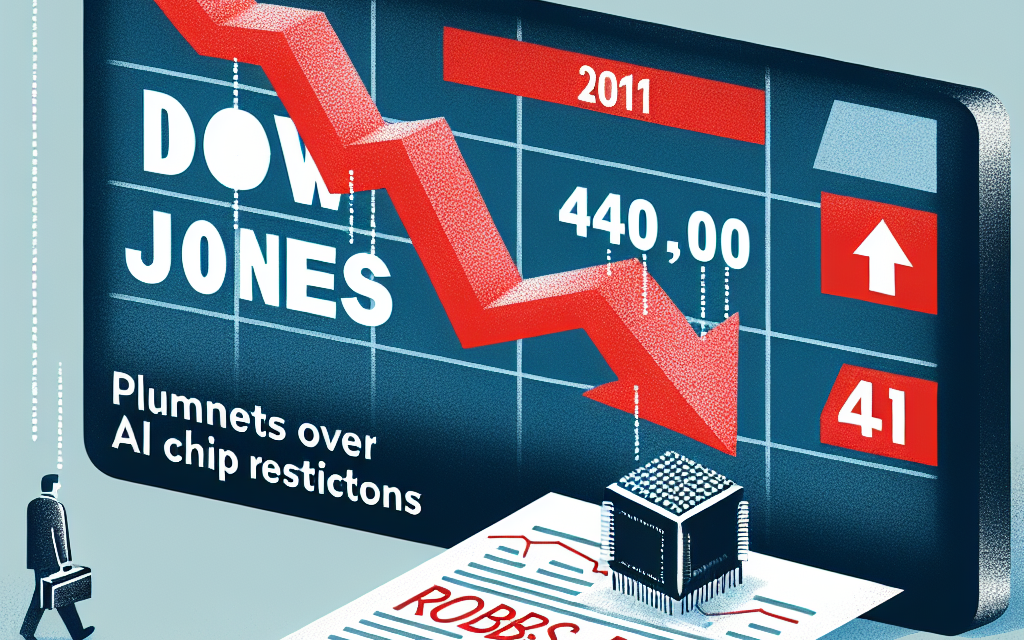“Market Turmoil: Dow Jones Dips 400 Points as Strong Jobs Data Contrasts with Nvidia’s AI Chip Setback.”
Introduction
The Dow Jones Industrial Average experienced a significant decline of 400 points, reflecting investor concerns despite robust jobs data that typically signals economic strength. This downturn was further exacerbated by Nvidia’s sharp drop in stock price, driven by new restrictions on AI chip exports. The combination of strong employment figures and regulatory challenges in the tech sector has created a volatile market environment, prompting investors to reassess their strategies amid shifting economic indicators.
Dow Jones Reaction to Strong Jobs Data
The recent fluctuations in the stock market have drawn significant attention, particularly the Dow Jones Industrial Average’s notable decline of 400 points, which occurred in the wake of robust jobs data released by the U.S. Department of Labor. This data, which indicated a stronger-than-expected labor market, has led to a complex interplay of investor sentiment and market dynamics. While strong job growth typically signals a healthy economy, it can also raise concerns about inflation and the potential for the Federal Reserve to maintain or even increase interest rates. Consequently, the market’s reaction to this data has been multifaceted, reflecting a blend of optimism about economic resilience and apprehension regarding monetary policy adjustments.
As the labor market continues to show strength, with unemployment rates remaining low and job creation exceeding forecasts, investors are grappling with the implications of such data. The prevailing sentiment among market participants is that a robust job market could compel the Federal Reserve to adopt a more hawkish stance. This potential shift in monetary policy is particularly concerning for investors who are wary of rising interest rates, which can dampen economic growth and negatively impact corporate profits. Thus, the Dow’s sharp decline can be interpreted as a reaction to these fears, as investors reassess their positions in light of the new economic indicators.
Moreover, the situation is further complicated by external factors, such as the recent restrictions imposed on Nvidia regarding its AI chip sales. Nvidia, a key player in the semiconductor industry, has seen its stock plummet as a result of these restrictions, which are aimed at curbing the export of advanced technology to certain countries. The decline in Nvidia’s stock not only reflects the company’s immediate challenges but also raises broader concerns about the future of the tech sector and its dependence on global supply chains. As Nvidia’s fortunes are closely tied to the growth of artificial intelligence and machine learning, any limitations on its ability to operate in international markets can have ripple effects throughout the industry.
In this context, the Dow’s reaction to the strong jobs data and Nvidia’s plummet illustrates the interconnectedness of various market sectors and the influence of macroeconomic indicators on investor behavior. The decline in the Dow can be seen as a reflection of a broader market correction, where investors are recalibrating their expectations in response to both economic data and geopolitical developments. As the market digests these factors, it becomes increasingly clear that volatility may persist, driven by ongoing uncertainties surrounding inflation, interest rates, and global trade dynamics.
In conclusion, the Dow Jones Industrial Average’s significant drop amid robust jobs data underscores the complexities of the current economic landscape. While strong job growth is generally a positive sign, it also raises questions about the sustainability of such growth in the face of potential monetary tightening. Additionally, the challenges faced by Nvidia highlight the vulnerabilities within the tech sector, further complicating the market’s response to economic indicators. As investors navigate this intricate environment, the interplay between labor market strength and external pressures will likely continue to shape market dynamics in the foreseeable future.
Impact of Job Growth on Stock Market Trends
The recent surge in job growth has had a profound impact on stock market trends, particularly as evidenced by the Dow Jones Industrial Average’s significant drop of 400 points. This decline, juxtaposed with robust employment data, highlights the complex relationship between job growth and market performance. While strong job numbers typically signal a healthy economy, they can also lead to concerns about inflation and interest rate hikes, which in turn can negatively affect stock prices.
As the labor market continues to show resilience, with unemployment rates remaining low and job creation exceeding expectations, investors are faced with a dual-edged sword. On one hand, the creation of new jobs is a positive indicator of economic strength, suggesting that consumer spending may remain robust. On the other hand, such growth can prompt the Federal Reserve to consider tightening monetary policy to combat potential inflationary pressures. This anticipation of higher interest rates often leads to a sell-off in equities, as investors reassess the future profitability of companies in a higher borrowing cost environment.
Moreover, the recent fluctuations in the stock market are not solely attributable to job growth figures. The technology sector, particularly companies like Nvidia, has also been significantly affected by regulatory changes and market sentiment surrounding artificial intelligence (AI) chip restrictions. Nvidia’s plummet in stock value underscores how external factors, such as government regulations, can exacerbate the volatility in the market. As the demand for AI technology surges, any limitations imposed on chip production or sales can lead to immediate and severe repercussions for companies heavily invested in this sector.
Transitioning from the broader economic indicators to specific market reactions, it becomes evident that the interplay between job growth and stock performance is intricate. For instance, while a thriving job market can lead to increased consumer confidence and spending, it can also raise fears of an overheated economy. This fear often manifests in the form of market corrections, as seen with the Dow’s recent decline. Investors are keenly aware that sustained job growth may lead to wage inflation, which could compel the Federal Reserve to act more aggressively in its monetary policy.
Furthermore, the implications of job growth extend beyond immediate market reactions. Long-term trends in employment can shape investor sentiment and influence strategic decisions. For example, sectors that benefit from increased consumer spending, such as retail and services, may see a boost in stock prices during periods of job growth. Conversely, sectors that are sensitive to interest rate changes, such as real estate and utilities, may experience downward pressure as investors recalibrate their expectations.
In conclusion, the relationship between job growth and stock market trends is multifaceted and influenced by a variety of factors, including monetary policy and sector-specific dynamics. The recent drop in the Dow Jones, alongside Nvidia’s struggles, serves as a reminder of the delicate balance that exists within the financial markets. As investors navigate these complexities, they must remain vigilant, recognizing that while job growth is a positive economic indicator, it can also lead to market volatility and uncertainty. Ultimately, understanding these dynamics is crucial for making informed investment decisions in an ever-evolving economic landscape.
Nvidia’s Stock Decline: Analyzing AI Chip Restrictions
Nvidia’s recent stock decline has captured the attention of investors and analysts alike, particularly in the context of the broader market fluctuations. The company’s shares plummeted significantly, driven in part by new restrictions on artificial intelligence (AI) chip exports. These restrictions, imposed by the U.S. government, aim to curb the proliferation of advanced technology that could potentially be utilized by adversarial nations. As a result, Nvidia, a leading player in the AI chip market, found itself grappling with the implications of these regulatory changes.
The restrictions have raised concerns about Nvidia’s ability to maintain its competitive edge in the rapidly evolving AI landscape. With the demand for AI technologies surging across various sectors, including healthcare, finance, and autonomous vehicles, the limitations on chip exports could hinder Nvidia’s growth trajectory. Investors are particularly wary of how these restrictions might affect the company’s revenue streams, especially given that a significant portion of Nvidia’s sales comes from international markets. Consequently, the stock’s decline reflects a broader apprehension about the company’s future performance in light of these regulatory challenges.
Moreover, the timing of the restrictions coincides with robust jobs data released by the U.S. Department of Labor, which typically signals a strong economy. However, the juxtaposition of positive economic indicators with Nvidia’s stock drop illustrates the complexities of the current market environment. While a strong labor market often bodes well for technology companies, the specific challenges facing Nvidia have overshadowed these positive signals. Investors are increasingly focused on the potential ramifications of the export restrictions, leading to a reevaluation of Nvidia’s stock value.
In addition to the export restrictions, Nvidia’s stock decline can also be attributed to broader market dynamics. The technology sector has been particularly volatile, with investors reacting to a myriad of factors, including interest rate hikes and inflation concerns. As the Federal Reserve continues to navigate its monetary policy, technology stocks, including Nvidia, have experienced heightened sensitivity to macroeconomic developments. This volatility has created an environment where even minor news can lead to significant stock price fluctuations, further exacerbating Nvidia’s challenges.
Furthermore, the competitive landscape for AI chips is intensifying, with other companies vying for market share. As new players enter the field, Nvidia must not only contend with regulatory hurdles but also with the pressure of maintaining its leadership position. The company’s ability to innovate and adapt to changing market conditions will be crucial in determining its long-term success. Investors are closely monitoring Nvidia’s strategic responses to these challenges, including potential adjustments to its product offerings and market strategies.
In conclusion, Nvidia’s stock decline amid the backdrop of AI chip restrictions highlights the intricate interplay between regulatory developments and market dynamics. While robust jobs data typically signals economic strength, the specific challenges facing Nvidia have led to a reevaluation of its stock value. As the company navigates these complexities, its future performance will depend on its ability to adapt to regulatory changes and maintain its competitive edge in an increasingly crowded market. Investors will undoubtedly continue to scrutinize Nvidia’s actions and the broader implications of these developments as they unfold.
Economic Indicators: Jobs Data vs. Market Performance
In recent trading sessions, the financial markets have experienced significant volatility, particularly highlighted by the Dow Jones Industrial Average’s sharp decline of 400 points. This downturn occurred in the context of robust jobs data released by the U.S. Department of Labor, which typically would be seen as a positive indicator for the economy. However, the juxtaposition of strong employment figures against the backdrop of rising interest rates and inflationary pressures has led to a complex market reaction. Investors are grappling with the implications of a tight labor market, which, while indicative of economic strength, also raises concerns about the Federal Reserve’s potential response in terms of monetary policy adjustments.
The jobs report revealed an increase in non-farm payrolls, surpassing analysts’ expectations and suggesting that the labor market remains resilient. This resilience is often interpreted as a sign that consumer spending may continue to drive economic growth. However, the market’s reaction was less than favorable, as traders began to speculate that the Federal Reserve might feel compelled to maintain or even accelerate its interest rate hikes to combat inflation. Higher interest rates can dampen economic growth by increasing borrowing costs for consumers and businesses alike, leading to a cautious sentiment among investors.
Moreover, the situation was exacerbated by developments in the technology sector, particularly concerning Nvidia, a leading player in the artificial intelligence (AI) chip market. Nvidia’s stock plummeted following news of potential restrictions on AI chip exports to certain countries. This news not only affected Nvidia’s stock price but also raised broader concerns about the future of the tech industry, which has been a significant driver of market performance in recent years. The combination of strong jobs data and negative news from the tech sector created a perfect storm, leading to heightened volatility in the markets.
As investors digested the implications of the jobs report alongside the developments in the tech industry, it became clear that the relationship between economic indicators and market performance is increasingly complex. While strong jobs data typically signals a healthy economy, it can also lead to fears of tighter monetary policy, which can weigh heavily on stock prices. This paradox illustrates the challenges faced by investors as they navigate a landscape marked by uncertainty and rapid changes.
Furthermore, the interplay between economic indicators and market sentiment is further complicated by geopolitical factors and global economic conditions. For instance, concerns about supply chain disruptions, inflationary pressures, and international trade tensions can all influence market performance, regardless of domestic employment figures. As such, investors must remain vigilant and adaptable, recognizing that the economic landscape is multifaceted and that various factors can converge to create unexpected market movements.
In conclusion, the recent drop in the Dow Jones amid robust jobs data and Nvidia’s stock decline underscores the intricate relationship between economic indicators and market performance. While strong employment figures are generally viewed as a positive sign, they can also trigger fears of increased interest rates, leading to market volatility. As the financial landscape continues to evolve, investors must carefully consider the broader implications of economic data and remain attuned to the myriad factors that can influence market dynamics.
Investor Sentiment Amid Market Volatility
Investor sentiment has been notably affected by recent market volatility, particularly in light of the Dow Jones Industrial Average’s significant drop of 400 points. This decline occurred against the backdrop of robust jobs data, which typically would be perceived as a positive indicator for the economy. However, the juxtaposition of strong employment figures with the market’s downturn has left many investors grappling with uncertainty. The labor market’s resilience, evidenced by lower unemployment rates and increased job creation, often signals economic strength. Yet, in this instance, it has raised concerns about potential interest rate hikes by the Federal Reserve, which could dampen economic growth and corporate profitability.
As investors digested the implications of the jobs report, the market’s reaction was swift and severe. The Dow’s decline reflects a broader apprehension regarding inflationary pressures and the possibility of tighter monetary policy. This sentiment is further compounded by the recent news surrounding Nvidia, a leading player in the semiconductor industry, which has seen its stock plummet due to new restrictions on AI chip exports. The restrictions not only impact Nvidia’s immediate revenue prospects but also raise questions about the future of the AI sector, which has been a significant driver of market enthusiasm in recent years.
The combination of these factors has created a complex landscape for investors. On one hand, the strong jobs data suggests a robust economy that could support corporate earnings; on the other hand, the potential for increased interest rates and regulatory challenges in key sectors like technology introduces a layer of risk that cannot be ignored. Consequently, many investors are reassessing their strategies, weighing the benefits of holding onto equities against the risks posed by a potentially volatile economic environment.
Moreover, the sentiment among investors is further influenced by the broader geopolitical landscape. Concerns about supply chain disruptions, trade tensions, and regulatory scrutiny are all contributing to a climate of caution. As companies navigate these challenges, investor confidence may waver, leading to increased market fluctuations. The recent downturn in the stock market serves as a reminder of the interconnectedness of various economic indicators and the delicate balance that investors must maintain.
In light of these developments, many market participants are adopting a more defensive posture. This shift is evident in the increased interest in sectors that are traditionally viewed as safe havens, such as utilities and consumer staples. Investors are also diversifying their portfolios to mitigate risk, seeking exposure to assets that may provide stability amid the uncertainty. This trend underscores the importance of adaptability in investment strategies, as market conditions can change rapidly.
As the market continues to react to economic data and regulatory developments, investor sentiment will likely remain volatile. The interplay between strong economic indicators and the potential for restrictive monetary policy creates a challenging environment for decision-making. In this context, investors must remain vigilant, continuously evaluating their positions and adjusting their strategies in response to evolving market dynamics. Ultimately, the ability to navigate this volatility will be crucial for achieving long-term investment success, as the landscape remains fraught with both opportunities and challenges.
The Future of AI Stocks Post-Regulation
The recent fluctuations in the stock market, particularly the significant drop of 400 points in the Dow Jones Industrial Average, have raised concerns among investors, especially in the context of robust jobs data that typically signals economic strength. This juxtaposition of strong employment figures and a declining stock market can be perplexing, yet it underscores the complexities of the current economic landscape. As investors grapple with these dynamics, the implications for artificial intelligence (AI) stocks, particularly in light of new regulatory measures, are becoming increasingly pronounced.
The recent plummet of Nvidia’s stock, attributed to restrictions on AI chip exports, serves as a stark reminder of how regulatory actions can swiftly alter market sentiment. Nvidia, a leader in AI technology, has been at the forefront of the AI revolution, providing essential hardware that powers numerous applications across various sectors. However, the introduction of restrictions aimed at curbing the proliferation of advanced AI technologies in certain regions has raised alarms among investors. This situation highlights a critical intersection between innovation and regulation, where the future trajectory of AI stocks may be significantly influenced by governmental policies.
As we look ahead, the future of AI stocks will likely be shaped by a combination of regulatory frameworks and market demand. On one hand, regulations can serve as a double-edged sword; while they may stifle certain aspects of growth, they can also create a more stable environment for investment. Investors may find that companies that adapt to these regulations and demonstrate compliance can emerge stronger in the long run. This adaptability could foster a new wave of innovation, as firms pivot to develop technologies that align with regulatory expectations.
Moreover, the global race for AI supremacy is intensifying, with countries vying to establish themselves as leaders in this transformative field. As nations implement their own regulatory measures, companies that can navigate these complexities will likely gain a competitive advantage. This scenario suggests that while immediate reactions to regulations may be negative, the long-term outlook for well-positioned AI firms could remain positive. Investors should consider the potential for growth in companies that prioritize compliance and ethical considerations in their AI development strategies.
In addition to regulatory impacts, the broader economic environment will also play a crucial role in shaping the future of AI stocks. The robust jobs data, while initially perceived as a positive indicator, may lead to concerns about inflation and interest rates, which can affect investment strategies across the board. As the Federal Reserve continues to navigate these economic challenges, the interplay between monetary policy and technological advancement will be critical. Investors must remain vigilant, as shifts in interest rates could influence capital allocation towards AI and other emerging technologies.
In conclusion, the future of AI stocks in a post-regulation landscape is fraught with both challenges and opportunities. While immediate market reactions may reflect uncertainty, the long-term potential for growth remains significant for companies that can adapt to regulatory changes and align their strategies with evolving market demands. As the economic environment continues to evolve, investors will need to stay informed and agile, recognizing that the intersection of regulation, innovation, and market dynamics will ultimately dictate the trajectory of AI stocks in the years to come.
Strategies for Navigating Market Drops and Recoveries
In the ever-evolving landscape of financial markets, investors often find themselves grappling with the implications of sudden market drops, such as the recent decline of the Dow Jones by 400 points, which was largely influenced by robust jobs data. This scenario underscores the importance of having effective strategies in place to navigate both market downturns and subsequent recoveries. Understanding the underlying factors that contribute to market fluctuations is crucial for making informed decisions, particularly in times of volatility.
One of the first strategies to consider during a market drop is to maintain a long-term perspective. While it is natural to feel anxious when faced with significant declines, history has shown that markets tend to recover over time. Investors who adopt a long-term view are often better positioned to ride out short-term fluctuations. This approach encourages individuals to focus on their overall investment goals rather than reacting impulsively to daily market movements. By doing so, they can avoid the pitfalls of panic selling, which can lead to locking in losses that might have otherwise been temporary.
In addition to maintaining a long-term perspective, diversification remains a cornerstone of effective investment strategy. By spreading investments across various asset classes, sectors, and geographic regions, investors can mitigate the risks associated with market drops. For instance, while the technology sector, exemplified by Nvidia’s recent plummet due to AI chip restrictions, may experience volatility, other sectors may perform differently under similar conditions. A well-diversified portfolio can help cushion the impact of losses in one area while allowing gains in another, thereby promoting overall stability.
Moreover, it is essential for investors to stay informed about market trends and economic indicators. The recent robust jobs data, which contributed to the Dow’s decline, serves as a reminder of how macroeconomic factors can influence market sentiment. By keeping abreast of economic reports, interest rate changes, and geopolitical developments, investors can make more informed decisions about when to enter or exit positions. This proactive approach can be particularly beneficial during periods of uncertainty, as it allows investors to anticipate potential market movements rather than react to them after the fact.
Another effective strategy during market downturns is to consider dollar-cost averaging. This technique involves consistently investing a fixed amount of money at regular intervals, regardless of market conditions. By doing so, investors can take advantage of lower prices during market drops, ultimately lowering their average cost per share. This disciplined approach not only helps to mitigate the emotional impact of market volatility but also positions investors to benefit from potential recoveries when the market rebounds.
Finally, it is crucial for investors to reassess their risk tolerance and investment strategy in light of changing market conditions. A significant market drop can serve as a wake-up call, prompting individuals to evaluate whether their current investment approach aligns with their financial goals and risk appetite. Adjusting asset allocations or rebalancing portfolios may be necessary to ensure that investments remain aligned with long-term objectives.
In conclusion, while market drops can be unsettling, employing a combination of long-term perspective, diversification, informed decision-making, dollar-cost averaging, and regular reassessment of risk tolerance can empower investors to navigate these challenges effectively. By adopting these strategies, individuals can not only weather the storm of market volatility but also position themselves for potential gains during subsequent recoveries.
Q&A
1. **What caused the Dow Jones to drop 400 points?**
The Dow Jones dropped 400 points primarily due to robust jobs data that raised concerns about potential interest rate hikes.
2. **How did the jobs data impact investor sentiment?**
The strong jobs data led investors to fear that the Federal Reserve might maintain or increase interest rates to combat inflation, negatively affecting market sentiment.
3. **What specific jobs data was released?**
The report indicated a significant increase in job creation and lower unemployment rates, suggesting a strong labor market.
4. **What happened to Nvidia’s stock?**
Nvidia’s stock plummeted due to new restrictions on AI chip exports, which raised concerns about future revenue and growth prospects.
5. **How did the AI chip restrictions affect Nvidia’s market position?**
The restrictions limited Nvidia’s ability to sell its advanced AI chips to certain markets, potentially impacting its competitive edge and profitability.
6. **What was the overall market reaction to these events?**
The overall market reacted negatively, with major indices, including the Dow, experiencing declines as investors reassessed their positions in light of the economic data and Nvidia’s situation.
7. **What are analysts predicting for the market following these developments?**
Analysts predict increased volatility in the market as investors digest the implications of the jobs data and Nvidia’s challenges, with a focus on upcoming Federal Reserve meetings.
Conclusion
The Dow Jones experienced a significant drop of 400 points, reflecting investor concerns despite robust jobs data, which typically signals economic strength. Concurrently, Nvidia’s stock plummeted due to new restrictions on AI chip exports, highlighting the impact of regulatory changes on technology companies. This combination of strong employment figures and negative market reactions underscores the complexities of the current economic landscape, where positive indicators can be overshadowed by sector-specific challenges.





